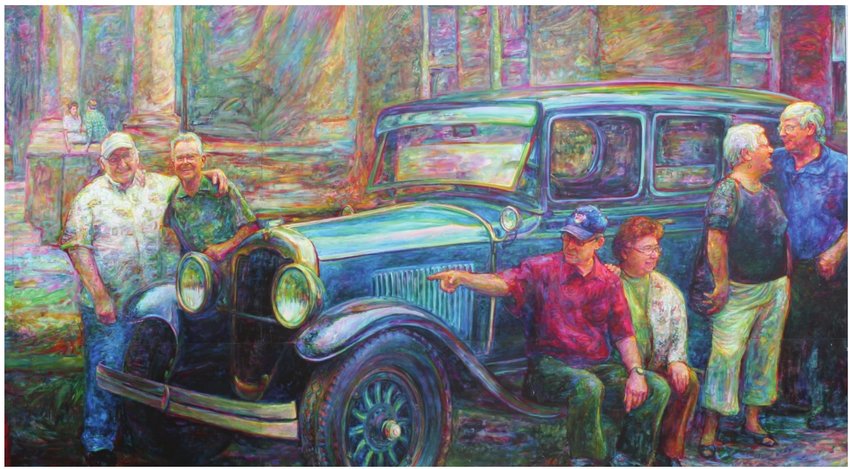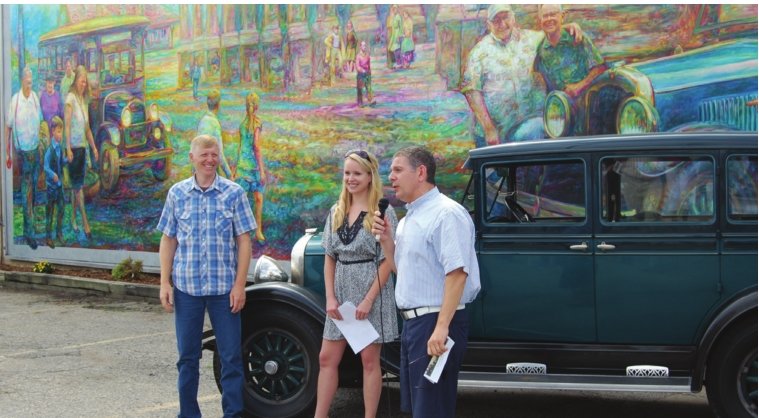
“Community Heart of REO” is an unintentionally provocative name for the 56-by- 28-foot mural that fills the north side of a Quality Dairy building, 1400 S. Washington Ave., in Lansing’s post-industrial REO Town.
Which community? The segregated, company-town enclave created by Ransom E. Olds or the diverse South Lansing of today? Out of 32 lovingly rendered people in the mural, from pigtailed, bouncing kids to kindly, graying elders, all are white.
One year after it went up in August 2015, people still react to the mural in two ways: Either they love it and see no problem with its all-white cast, or the whiteness of the wall is the first thing they notice.
Jose Flores said the mural is “beautiful, but by far it doesn’t represent the community.”
Flores is the owner of J. Bruno’s Salon and Barbershop, tucked into a tiny historic building at 1501 S. Washington Ave., less than a block away from the mural. He has run his shop there for about six months and has been a barber in South Lansing about two years.
“There’s nothing but — I’m sorry, but there’s nothing but white people up on that wall,” Flores said. “To me, it points out a specific time in history that was all white.”
He regularly hears from clients of color who are disappointed because their parents or grandparents worked at REO all their lives, but nobody in the mural looks like them.
“It’s a beautiful mural, but to them, it reminds them of a different time, a racist time,” Flores said. “There aren’t any African-Americans; there aren’t any Latinos.”
The mural may look like a small town idyll straight out of a Norman Rockwell collection, but it’s grounded in reality. Grand Ledge artist Tony Hendrick assembled a cast of actual ex-employees of REO Motor Car Co. and its successor, truck manufacturer Diamond REO, for a photo shoot before he started work, and based the mural on the photos.
“To the extent that it’s representing the labor force that existed at REO for most of its history, it’s not all that inaccurate,” said Lisa Fine. A Michigan State University historian, Fine is author of “Reo Joe,” an extensive study of the REO plant’s history and culture.
“(REO) was a much more white dominated plant than many other auto plants through the 20th century,” Fine said. “Until the late ‘60s, any kind of minority worker was quite rare.”
Fine’s book quotes from Lansing native Malcolm X’s autobiography: “Do you remember REO? It was manufactured in Lansing and R.E. Olds, the man after whom it was named, also lived in Lansing. When the war came along, they hired some Negro janitors.”
The mural harks back to a vanished era, but it’s not a sepia-toned historical vignette. Hendrick blurred the period by painting his models in modern dress, socializing and schmoozing in the shadow of the defunct REO Clubhouse. The building, constructed in 1917 and razed in 1979, was the social hub for employees of the auto manufacturing giant that dominated the district south of downtown Lansing for much of the 20th century.
“Obviously, the clubhouse isn’t here any more, but the people look like they could walk off the picture and onto the streets of Lansing,” Fine said. “These are like the people I interviewed.”
To enhance the effect, a few arms and legs even reach out of the frame, as if the people really are walking off the wall.
The use of modern dress and the word “community” in the mural’s title shifts the painting’s center of gravity from past to present. The result is a mixed message.
“It looks like a certain segment of presentday Lansingites in a historical setting,” Fine said. “Very strange.”
Without intending a pun on REO Town, Fine said it’s not always easy to honor history without “reifying” it, or dragging it back into present-day reality. Hendrick’s mural confuses the issue further by pulling the segregated community of the past onto today’s streets.
“Welcome to the world of the historian,” Fine said. “How can we be true to the past in a way that’s not glorifying it? It’s not easy.”
Paul Trowbridge, another gregarious REO Town barber — is there any other kind? — opened Cuttin’ Up barbershop in REO Town in 2012. Trowbridge gladly takes all comers, but many of his customers are African-American and Latino.
Trowbridge said the mural comes up frequently in conversation at the shop.
“We’re talking about diversity, but you’re not making everybody feel comfortable,” he said. “I get all walks. I got Latino dudes saying, ‘Hey, there are no brown people in that picture.’ I thought maybe the artist would figure that out but — ahhh.”
He shrugged.
Trowbridge was surprised when he saw it go up in final form.
“I went home and told my wife, ‘This ain’t right,’” he said. He brought it up at a meeting of the REO Town Commercial Association, of which he is a member.

“My wife said, ‘Don’t go in there being the angry black dude,’” he recalled. “I didn’t want to do that, but I had to say something.”
Nothing came of it.
“It was a done deal, and the artist wasn’t going to go change anything,” Trowbridge said.
But Hendrick said he has given the question a lot of thought. He knew the mural’s lack of diversity wasn’t going unnoticed before it was even finished. As he worked on the wall, a carload of teenagers drove by on Washington Avenue.
“One of them yelled out the window, ‘Great mural, put some black people in it!’” Hendrick recalled.
He found that reactions to the mural were divided, usually by age. Shortly before the incident with the car, an older lady drove by with her son as Hendrick worked on the wall.
“She made her son come back and stop so she could take a look at it,” Hendrick said. “She was in tears because she remembered the times she had at the clubhouse.”
Hendrick was fascinated by the difference between the two encounters. “I thought at the time that this mural, and any art, offers a reflection of what happens inside the viewer,” Hendrick said.
Hendrick said the question of racial diversity came up during planning for the project.
“We attempted to get somebody who could represent some racial diversity, but they were no longer alive,” he said. A Native American was present at the photo shoot but didn’t end up in the mural for artistic reasons, Hendrick said.
Toward the end of REO’s reign in the area, the company made an effort to hire minority workers.
“I understand (Hendrick’s) difficulty, but it’s not true that there were no black people in REO,” Fine said. “Not in any great numbers, or perhaps in equal types of positions, but he could have done one.”
Flores wasn’t sure that a piece of art is worth the fuss, but conversations with clients convinced him otherwise.
“At first, I was like, ‘Oh, it’s a mural, leave it alone,’” Flores said. “But as I heard why it upset them, it began to make sense to me.”
Flores is related to the owner of longtime REO Town restaurant Ramon’s South, formerly located on the corner of South Street and Washington Avenue.
“For years it was the only thing that brought people to REO Town,” Flores said of the restaurant. “There’s not one Mexican on that mural.”
Fine gives Hendrick credit for trying to find people of color but suggested that more could have been done.
“Artists don’t have to abide by the same set of rules historians do,” she said. “Think about the smash hit ‘Hamilton.’ It is possible to be true to history but also push the envelope a little bit and include, in a rendering of the past, populations that have been excluded.”
The problem, to Hendrick, is that many nods to diversity in public art come off as forced or phony. Hendrick had his heart set on using real people. He feels that painting new faces or fictitious people into the scene would “dishonor the artwork.”
Hendrick feels that his approach “opens up a more realistic door.”
“Now we are having a conversation,” he said. “Maybe somebody else is having that conversation.”
They are indeed. After several conversations with customers, Flores, the barber, is planning to put a little mural on the back of his tiny barber shop as an answer to the pallid panorama across the street.
“To be honest with you, I don’t look at it anymore,” he said.
Support City Pulse - Donate Today!
Comments
No comments on this item Please log in to comment by clicking here